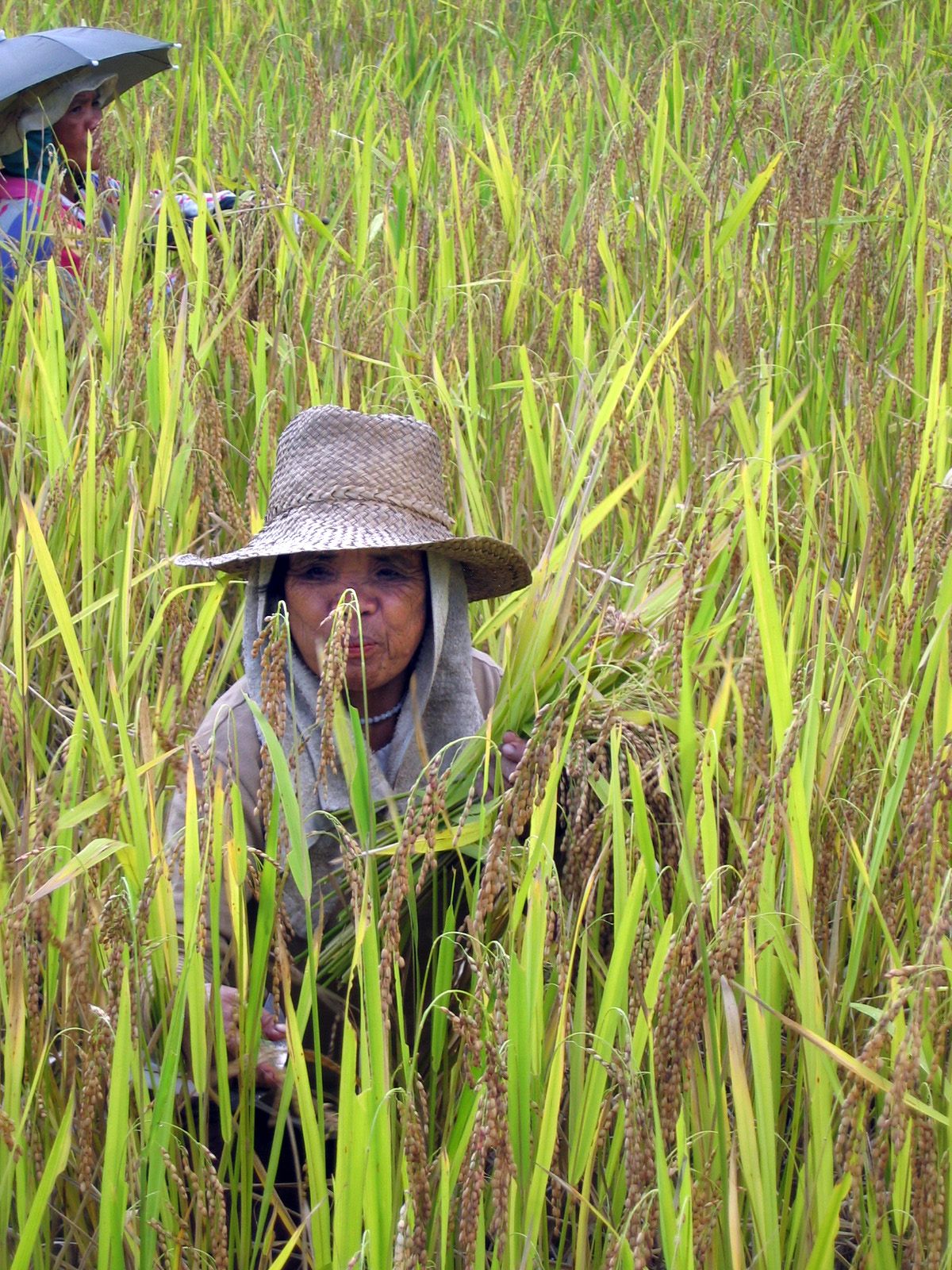Rice Riches
In many areas of Asia, it is considered a sacred food source
In the Philippines, Ifugao Co-op member Imbangad Nahuyamen harvests Tinawon rice one stalk at a time. Photos Courtesy of Eighth Wonder (Photos Courtesy of Eighth Wonder)
‘Have you eaten rice yet?” This common greeting in Thailand gives evidence of the important role rice plays in daily life. “Normally we eat rice three times a day,” says Somkhit Buerger, who teaches Thai cooking in Spokane. “My mom taught me, when you eat rice, be careful and don’t spill. Rice comes with hard work.”
Buerger remembers visiting the rice fields in the Phetehabun province of central Thailand as a little girl. “I would go with my grandmother and we would bring an offering and leave it in the corner of the field. We prayed for the rice because we appreciate that it feeds us.”
Rice rituals
For many cultures throughout Asia, rice holds deep religious meaning. Farmers have been cultivating rice along fertile river valleys in South Asia and China for thousands of years. As the main food source and necessary for survival, rice was considered sacred and rituals developed around planting and harvesting rice.
Some of these rituals are still being practiced today. In the high rice terraces of the Philippines, red flowers are placed on each terrace to keep the evil spirits away. Various ceremonies are performed by native priests throughout the growing season. A human-shaped carved figurine known as a bulul, or ‘rice god’ is used in rituals of thanksgiving and protection and placed in rice granaries to guard the grain against worldly and spiritual threats.
Mountain rice terraces
The Cordillera Mountain range in the Philippines is home to six indigenous tribes whose lives traditionally revolved primarily around the cultivation of rice. The 300 varieties of rice native to this area are grown in spectacular, hand-carved stone and earth integrated terraces that are self-irrigated from the mountain rains.
In 1995, UNESCO designated five of these 3,000-year-old terraces as World Heritage Sites. “Rice for these people is the center of their culture,” says Mary Hensley, owner of Eighth Wonder, a Montana based Fair Trade importer of select varieties of rice from the Cordilleras.
“As fewer and fewer people farm the terraces and the younger generation leaves the mountain in search of economic opportunity elsewhere, the connections to their culture have rapidly deteriorated,” Hensley notes. “Supporting the farmers to continue to farm their terraces and planting their native rice is one small way of helping the people to keep some parts of their culture alive for future generations.”
Importing heirloom rice
“We’re all in it together, learning how to do it,” says Hensley, who founded her company in 2006. She had visited the Cordillera Mountains in the 1970s as a Peace Corps volunteer and recalls “one of my favorite memories was the wonderful varieties of rice. It was nourishing … it smelled so good you couldn’t wait to eat it.”
The 250 farmers Hensley works with were primarily subsistence farmers who had never cultivated rice as a cash crop. Every step has been a challenge, from teaching the farmers to form co-operatives, to developing rice milling equipment that would process the older, thicker hulled heirloom rice to finding adequate electricity in the high mountain villages. Currently, Eighth Wonder is the only rice exporter in the Philippines, one the world’s largest rice importers.
Hensley selected seven kinds of heirloom rice to import, varieties that had been grown for centuries in the high terraces. (Heirloom rice is rice that has been documented to have been grown before 1950 when high-yielding rice was introduced.)
“If this (rice) could be developed into a high-end gourmet food product, the people who wanted could stay,” explains Hensley. “This project has ended up working with the most marginalized people – those who are too poor to leave, or the women who were left behind. This is thousands of people.”
Ulikan Red Rice with Cilantro, Lime and Coconut
Adapted from Indian Harvest Specialtifoods recipe by Mary Hensley, Eighth Wonder. Serve this dish with garlic grilled fish or shrimp.
1 cup Eighth Wonder Ulikan red rice (available at the Main Market Co-op) or substitute any long-grain red rice
1½ cups chicken stock
1-2 tablespoons chopped fresh cilantro (or to taste)
1½ teaspoons fresh lime juice
¼ cup coconut milk
Salt and pepper to taste
Rinse rice vigorously in cold water 2 to 3 times or until water runs clear. Bring 1 ½ cups chicken stock to a boil in medium saucepan. Stir in red rice. Cover and simmer on low for 15 minutes. Stir in remaining ingredients and let rest (covered) for 10 minutes or until desired texture is reached. Season to taste with salt and pepper.
Yield: 3-4 servings
Heirloom Rice and Curried Lentils
Courtesy of Mary Hensley, Eighth Wonder
1 cup heirloom rice (or substitute Calrose or brown rice)
1 cup French green or yellow lentils
4 cups water
1 (14½ -ounce) can diced tomatoes
1 medium onion, chopped
3 carrots, peeled and chopped
1 teaspoon salt (or to taste)
1 tablespoon curry powder (or to taste)
1 teaspoon cumin
Pinch cayenne pepper
1½ teaspoons dry mustard
2 tablespoons vegetable oil
1 clove garlic, minced
Cook rice according to directions on product packaging. Set aside. Mix lentils, water, tomatoes, onions, carrots, salt, curry powder, cumin and cayenne together in a large cooking pot. Heat to boiling, stir and reduce heat to simmer. Cover and cook for 45 minutes, stirring occasionally and adding more water as needed. Add the mustard, vegetable oil and minced garlic. Simmer 10 to 15 minutes more until lentils are soft. Serve over rice.
Yield: 3-4 servings
Black Sticky Rice Pudding
Courtesy of Somkhit Buerger, Spokane
¼ cup sticky rice
½ cup black sticky rice (see note)
6 ounces palm sugar candy (see note)
1 cup coconut milk
¼ teaspoon salt
1 cup water
Mix the white and black sticky rice together. Wash rice until water runs clear. Drain off water. Place rice in a bowl and cover with clean water, allowing rice to soak for at least 4 hours. Drain the rice and place it in a medium saucepan with 1 cup water. Cook for 10 minutes. When the water is reduced and the sticky rice is cooked, add the palm sugar candy. Reduce the heat and simmer until palm sugar is dissolved and the sticky rice thickens. In a separate saucepan, combine the coconut milk and salt. Cook for 5 minutes. Set aside. To serve, place a portion of the warm rice pudding into a dessert cup and top with coconut milk. Serve warm.
Note: Find sticky rice and palm sugar candy at Asian markets.
Yield: 3 servings.
Chorizo Heirloom Rice
Courtesy of Audris Romualdez and Eighth Wonder
1 cup Eighth Wonder Ulikan red rice (available at the Main Market Co-op) or substitute any long-grain red rice
3-4 cloves crushed garlic
1 6-inch long piece of chorizo sausage, sliced (about ¼ pound, see note)
¼ cup olive oil
½ cup thinly sliced scallion
4 sliced tomatoes
1 teaspoon capers
½ of a chicken bouillon cube
Chopped dried thyme leaves (optional)
Salt and pepper
Cook red rice according to package. Set aside to cool. Sauté garlic in olive oil until light golden brown. Add sliced chorizo and chicken bouillon cube. Add scallions and keep stirring for about 1 minute. Add sliced tomatoes and continue sautéing until they become tender. Add thyme and capers and mix for about 30 seconds. Finally, add the cooked rice and mix well. Season with salt and pepper and serve hot.
Note: Substitute chicken or shrimp if chorizo is not available.
Yield: 3-4 servings.

